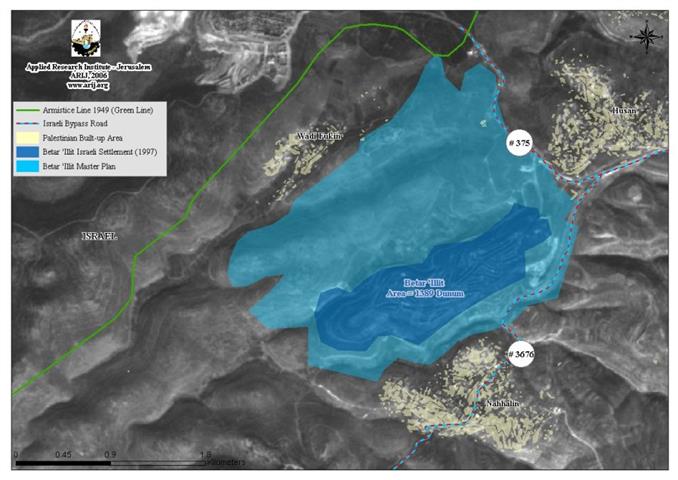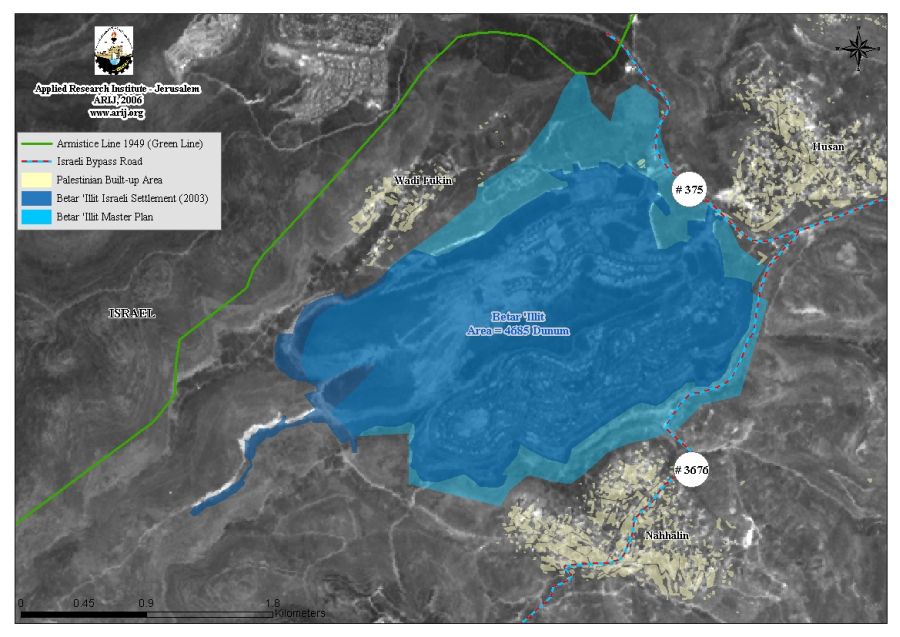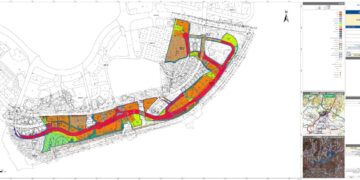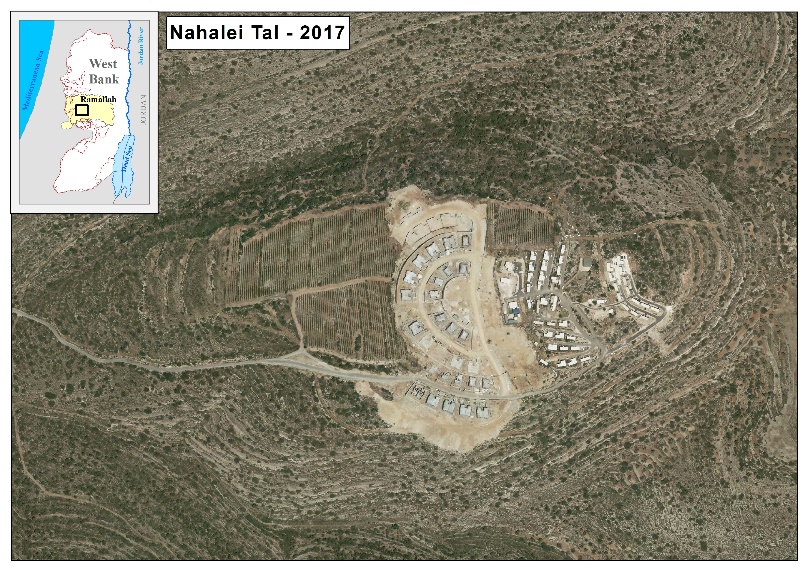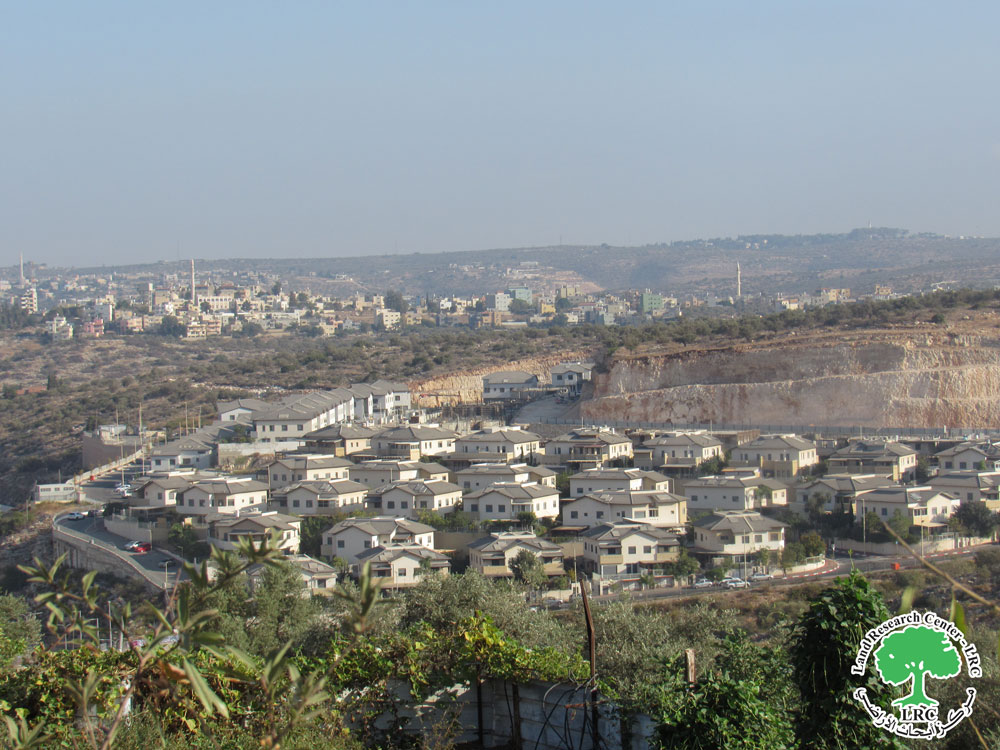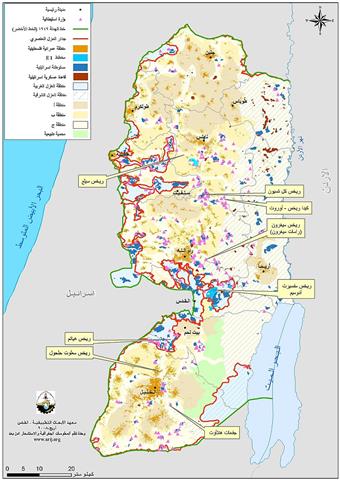On March 25, 2008, it was published on the website of the Israeli daily newspaper 'New Day' (Yoom Khadash) that the Jewish Group 'United Torah supports the Israeli Governments' decision to develop construction in the settlement of Beitar Illit, south-west of Bethlehem city. Adding, construction will include 800 new housing units in the settlement under what it calls 'Settlement's developing Project'.
Beitar Illit settlements stands on a total land area of 4685 dunums of land originally confiscated from Husan, Nahalin and Wad Fukin villages in year 1985. See Table 1,
|
Table 1: Palestinian Lands confiscated for the construction of Betar Illit Settlement. |
|||
|
Betar Illit |
Confiscated Area (Dunums) |
Palestinian Community |
Total Land Area = Area of Settlement (dunums) |
|
3431 |
Husan |
4686 |
|
|
567 |
Wad Fukin |
||
|
688 |
Nahalin |
||
Source: ARIJ GIS Database – 2008
In addition to being identified as the fastest growing settlement in the West Bank; Betar Illit settlement is considered one of the largest Israeli settlements in the West Bank in terms of Area and is inhabited by almost 35000 Israeli settlers. Throughout the previous years, the Settlement witnessed vertical expansion through the addition of new housing units that were either published by the Israeli Civil Administration or The Israeli Ministry of Housing and Construction in an attempt to intensify its existence within Gush Etzion settlements' bloc, which is under plans to become part of 'Greater Jerusalem'. See Table 2,
|
Table 2: Israeli Tenders to build housing units in Betar Illit Settlement southwest of Bethlehem city during the period between 2004 & 2008 |
||
|
Settlement |
No. ofHousing Units |
Announcement Date |
|
BetarIllit |
604 |
17-Aug-04 |
|
500 |
25-Feb-05 |
|
|
400 |
20-Jun-05 |
|
|
72 |
4-Aug-05 |
|
|
150 |
26-Jan-05 |
|
|
2000 |
18-Jan-06 |
|
|
342 |
4-Sep-06 |
|
|
32 |
17-Mar-08 |
|
|
Total |
4100 |
|
Source: ARIJ GIS Database – 2008
In addition to the aforementioned, the settlement witnessed horizontal expansion that was on the expense of the neighboring Palestinian villages (See Table 1) which contributed much to an increase in settlement's area throughout the years of Israeli occupation, hence the settlement of Betar Illit original in 1985 (150 dunums) has increased by 3000%. See Table 3,
|
Table 3: Betar Illit Settlement throughout the years of Israeli Occupation |
|||
|
Year of Establishment 1985 |
|||
|
Settlement |
Year |
Area (Dunum) |
PercentofIncrease |
|
BetarIllit |
1997 |
1389 |
826% of 1985 |
|
2003 |
4187 |
201% from 1997
|
|
|
2006 |
4685 |
12% of 2003 |
|
Source: ARIJ GIS Database – 2008
Map 1: Betar Illit Settlement in 1997
Map 2: Betar Illit Settlement in 2003
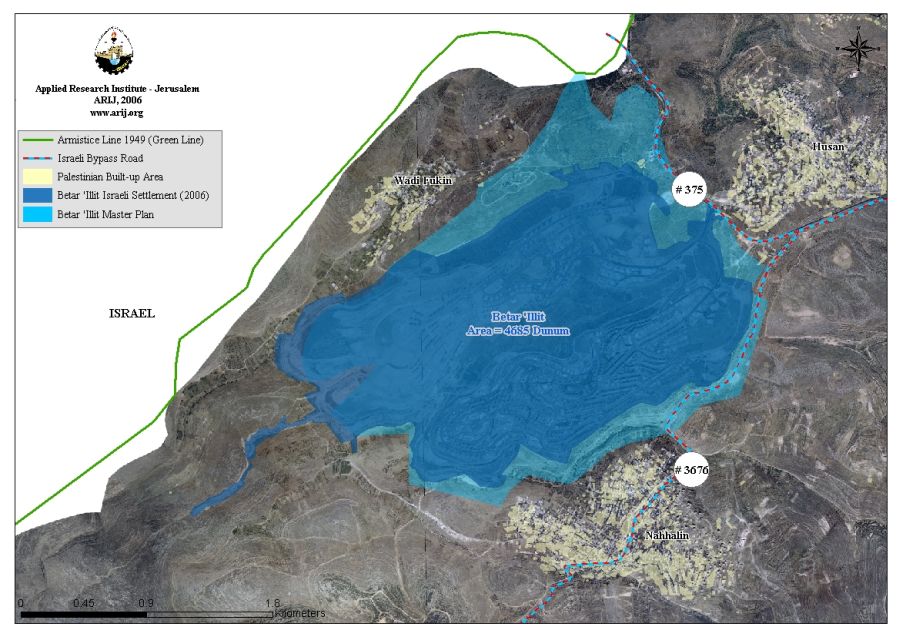
Map 3: Betar Illit Settlement in 2006
Betar Illit Settlement and the Israeli Segregation Wall Plan
When Israel commenced the construction of the Segregation Wall in June 2002, it aimed at annexing the largest number of Israeli settlements to Israel upholding its fake claim that the wall comes to provide security for settlements and settlers living in them. The focus was on Jerusalem city where Israel, through the construction of the wall, could actually redraw the borders of the city to include the largest Israeli settlements' blocs around the city (Ma'ale Adumim Settlements' Bloc., Giv'at Ze'ev Settlements' Bloc, and Gush Etzion Settlements' Bloc, which includes Betar Illit Settlement in addition to 10 other Israeli settlements under what it calls 'Greater Jerusalem Project'. At the same time, the Segregation Wall will exclude 15 Palestinian communities out of the city's municipal borders, depriving them their agricultural lands and denying them their right to expand and develop.
'Greater Jerusalem' as a concept started to develop during the late 1970s early 1980s, when the Israeli government expanded the area of settlements' construction outside the Israeli defined Jerusalem municipal boundary in order to create facts on the ground with settlements' continuity around Jerusalem and cut the territorial continuity of East Jerusalem with the rest of the West Bank, all of which to increase Jewish population around Jerusalem and impose Jewish demographic supremacy that would strengthen the hold on Jerusalem.
New Israeli Housing Units in West Bank Settlements
The Israeli Ministry of Housing and Construction, and the Israeli Municipality of Jerusalem revealed since the beginning of 2008 dozens of tenders and plans for additional housing units in Israeli settlements in the West Bank, out of which, five are located in East Jerusalem, five others in Bethlehem Governorate, two in Salfit and in Qalqilyah. See Table 4 for tenders that were issued during the last months
|
No. |
Table 4: Israeli Tenders in settlements of the West Bank |
||||
|
Settlement |
No. of Housing Units |
Announcing Party |
Date of Announcement |
Governorate |
|
| 1 | Ash Shiekh Jarrah | 200 | Nahalat Shim'on | January 28, 2008 | Bethlehem |
|
2 |
Har Homa |
360 |
Ministry of Housing and Construction |
February 12, 2008 |
Bethlehem |
|
3 |
Pisgat Ze'ev |
750 |
Ministry of Housing and Construction |
February 12, 2008 |
Jerusalem |
|
4 |
Neve Yakoov |
400 |
Jerusalem Municipality |
March 10, 2008 |
Jerusalem |
|
5 |
Pisgat Ze'ev |
750 |
Ministry of Housing and Construction |
March 10, 2008 |
Jerusalem |
|
6 |
Agan Ayalot, Giv'at Ze'ev |
750 |
Israeli Prime Minister |
March 10, 2008 |
Jerusalem |
|
7 |
Har Homa |
350 |
Ministry of Housing and Construction |
March 10, 2008 |
Bethlehem |
|
8 |
Ma'ale Adumim |
52 |
Ministry of Housing and Construction |
March 10, 2008 |
Jerusalem |
|
9 |
Ariel |
48 |
Israeli Authorities |
March 10, 2008 |
Salfit |
|
10 |
Elkana |
288 |
Ministry of Housing and Construction |
March 12, 2008 |
Qalqilyiah |
|
11 |
Kedmat Zion |
800 |
Israeli Shas Party |
March 12, 2008 |
Jerusalem |
|
12 |
Ma'ale Adumim |
89 |
Israeli Authorities |
March 13, 2008 |
Jerusalem |
|
13 |
Giv'at Hamatos |
2337 |
Building and Planning committee at Jerusalem Municipality |
March 15, 2008 |
Jerusalem |
|
14 |
Betar Illit |
32 |
Israeli Authorities |
March 17, 2008 |
Bethlehem |
|
15 |
Sha'ar Tekvah |
32 |
Israeli Authorities |
March 17, 2008 |
Qalqilyiah |
|
16 |
Elkana 32 |
Israeli Authorities |
March 17, 2008 |
Salfit |
|
|
17 |
Ele'zer |
80 |
Israeli Minister of Defense |
March 23, 2008 |
Bethlehem |
|
18 |
Pisgat Ze'ev |
600 |
Jerusalem Municipality |
March 30, 2008 |
Bethlehem |
|
19 |
Ras Al Amoud (Ma'ale David) |
110 |
Jerusalem Municipality |
April 20, 2008 |
|
|
20 |
Gilo |
150 |
Jerusalem Municipality |
May 12, 2008 |
|
|
|
Total |
8210 |
|
|
|
Source: ARIJ Monthly Reports Database � 2008
Below is a brief on each settlement that received new housing units' tenders and the lands that were confiscated from Palestinian communities for the construction of these settlements.
| Table 5: Israeli settlements targeted for Expansion | |||
| Settlement Name | Palestinian Community | Area of Land Confiscated | Confiscated Area = Current Settlement Areadunum |
| Ash Shiekh Jarrah neighborhood in Jerusalem (French Hill): One of the first settlements that were established following Israel's occupation of Jerusalem in 1967. It was established on lands originally confiscate from lands of Al Esawiyeh. The Settlement stands on an area of 687 and is inhabited by 7010 Israeli settlers | Esawiyeh | 687 | 687 |
| Giv'at Ze'ev: lies to the northwest of Jerusalem city, on an area of 2856 dunums originally confiscated from Betunia town and Al Jib village in 1982. Today, the settlement is inhabited by more that 10800 Israeli Settlers. | Betunia | 1240 | 2856 |
| Al | 1616 | ||
| Harhoma settlement: lies to the south of Jerusalem city, on an area of 2205 dunums that were confiscated from lands of Beit Sahour and Bethlehem in 1997. The settlement is inhabited by 4604 Israeli settlers. | Bethlehem | 930
|
2205 |
| BeitSahour | 416 | ||
| Jerusalem | 859 | ||
| Neve Yaakov: lies to the north of Jerusalem city, on an area of 1241 dunums that were confiscated from the lands of Ar Ram, Hizma and Beit Hanina in 1972. The settlement is inhabited by 21404 Israeli settlers. | Beit Hanina | 525 | 1241 |
| Hizma | 505 | ||
| ArRam | 109 | ||
| Ma'ale Adumim Settlement: lies to the east of Jerusalem city, on an area of 6621 dunums that was confiscated from lands of Al Esawiyeh, Al Ezariyeh, At Tur, Al Khan Al Ahmar, and Abu Dis in 1975. The settlement is inhabited by more than 32000 Israeli settlers. | Isawiyeh | 6621 | |
| Al Khan AlAhmar | 932 | ||
| Al Ezariyeh | 3434 | ||
| At Tur | 703 | ||
| AbuDis | 1427 | ||
| Giv'at Hamatos settlement: located to the south of Jerusalem city, on an area of 288 dunums that were confiscated from lands of Beit Safafa village in 1991. The settlement is inhabited by 1189 Israeli settlers. | Beit Safafa | 288 | 288 |
| Elkana settlement: lies to the southeast of Qalqilyah city, on an area of 1514 dunums that were confiscated from lands of Mas-ha, Saniryia, and Az Zawyah in 1977. The settlement is inhabited by 3000 Israeli settlers. | Saniryia | 77 | 1514 |
| Mas-ha | 1414 | ||
| AzZawiyeh | 23 | ||
| Ariel Settlement: lies to the north of Salfit city, on lands owned by villages of Kifl Hareth, Salfit, Marda and Iskaka in 1978. The settlement is inhabited by more than 16500 Israeli settlers | KiflHareth | 534 | 5184 |
| Marda | 3195 | ||
| Iskaka | 131 | ||
| Salfit | 1324 | ||
| Pisgat Ze'ev settlement: lies to the north of Jerusalem city, on an area of 1545 dunums were confiscated from the lands of Hizma and Beit Hanina towns in 1985. Today, the settlement is inhabited by more than 41000 Israeli Settlers. | BeitHanina | 1152 | 1546 |
| Hizma | 148 | ||
| Jerusalem | 246 | ||
| Betar Illit Settlement | Husan | 3431 | 4686 |
| WadiFukin | 567 | ||
| Nahhalin | 688 | ||
| Sha'are Tekvah settlement: lies to the southeast of Qalqilyah city, on an area of 1063 dunums that were confiscated from lands of Saniryia and Mas-ha in 1982. The settlement is inhabited by more than 3800 Israeli settlers. | Saniryia | 755 | 1063 |
| Mas-ha | 308 | ||
| Efrat Settlement: lies to southwest of Bethlehem city, on an area of 2180 dunums that were owned by villages of Al Khader and Artas villages in 1979. The settlement is inhabited by 7700 Israeli settlers. | AlKhader | 1709 | 2180 |
| Artas | 471 | ||
| Eli'zer settlement: Lies to the southwest of Bethlehem city, on an area of 536 dunums that were originally confiscated from lands of Al Khader village in 1975. The settlement is inhabited by more than 1300 Israeli settlers. | AlKhader | 536 | 536 |
| Total | 30607 | ||
Source: ARIJ GIS Unit � 2008
To conclude:-
The nature of Israeli expansions in West Bank settlements took a different direction as it is more focused, or only focus on settlements included within the seam zone area (those located west of the Segregation Wall in the western Segregation Zone) with particular emphasis in those within the Greater Jerusalem whose boundary will be defined for a second time in an illegal manner by the Segregation Wall, which in its tern will act as a de-facto border for the future Israeli state.
Prepared by
The Applied Research Institute – Jerusalem


